
Wellbeing in the Workplace: A Business Case
OVERVIEW
Over the past decade, wellbeing has evolved to play a crucial role in business success. However, until now its real importance in an organization’s survival has been unclear. The COVID-19 pandemic has thrust wellbeing even further into the spotlight, prompting organizations to relook at the steps they need to take to not only survive, but also thrive, while ensuring the health and safety of their employees.
“Many of the organizations that managed to get their pandemic responses right early on and are adapting to the new normal with greater ease today seem to share one thing in common: an ongoing interest and investment in the wellbeing of their workforce – and stakeholders everywhere are starting to take notice,” says Dr. Amitabh Deka, head of wellbeing solutions, South Asia and Aon Care.
To highlight the link between wellbeing and performance for organizations across Asia Pacific, Aon’s 2021 Global Wellbeing Survey polled employees in 1,648 companies across 40 countries to assess how organizational culture, environment, leadership, goals and demographics come together to impact wellbeing and business performance.
Key drivers in developing a business case for wellbeing around the world
Companies in APAC have been vocal about the role of ‘compelling research on how wellbeing programs would help employees and company’ in building a case for Wellbeing (APAC highest at 58 percent).
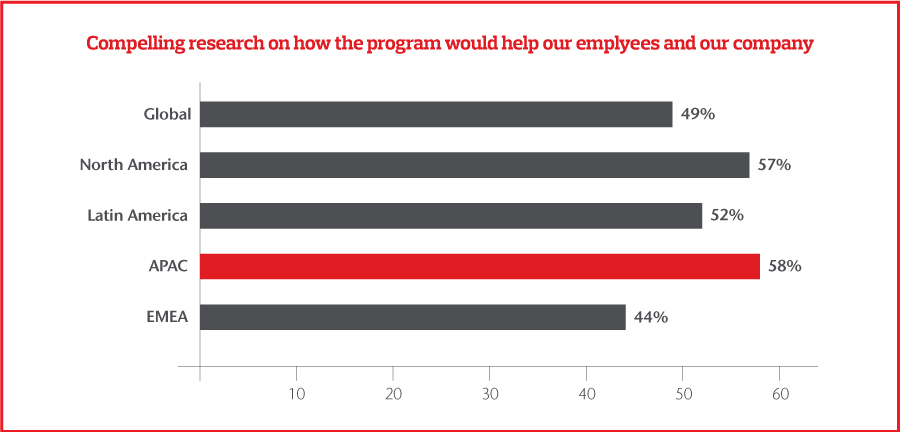
IN DEPTH
There has been growing acknowledgement globally that work environment and organizational culture are critical issues affecting employee wellbeing. In fact, the Global Wellbeing survey showed that organizations in the Asia Pacific region ranked working environment/culture as a critical issue affecting wellbeing higher than any other global region.
Top 5 critical issues affecting employee wellbeing around the world
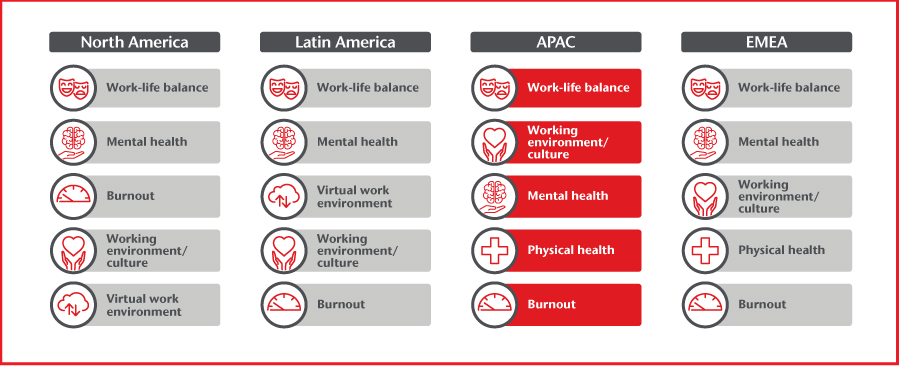
To understand its implications on a business, it is fundamental to understand what wellbeing entails. In Aon’s 2021 Global Wellbeing Survey, five dimensions are considered: physical, emotional, social, financial, and work-life balance. As all these dimensions are interconnected, addressing them individually or in isolation is unlikely to deliver desired outcomes in terms of behavior change.
“As it stands in APAC, the survey indicates that physical wellbeing is being prioritized the most, with 76 percent of respondents reporting it as being the cornerstone of their organizational strategy,” says Dr Deka.
“At its core, this dimension looks at an employee’s ability to make healthy choices related to physical fitness and maximize productivity at work,” he explains. “On the other hand, financial wellbeing recorded the least responses at only 53 percent, indicating that organizations may need to do more to equip and enable their employees to not only manage their financial life at present, but also prepare for the future and unexpected bumps along the way – especially during these uncertain times.”
The impact of wellbeing on loyalty
Although profit and customer satisfaction remain the key indicators of business performance, employee engagement, turnover and satisfaction, all elements directly influenced by effective wellbeing initiatives, are also being brought to the forefront, especially in the APAC region.
How wellbeing initiatives impact businesses in APAC today
With the realization that employee engagement, productivity and loyalty are valuable business outcomes impacted by wellbeing, it is about time that wellbeing is viewed through a business risk lens instead of a budget item lens.
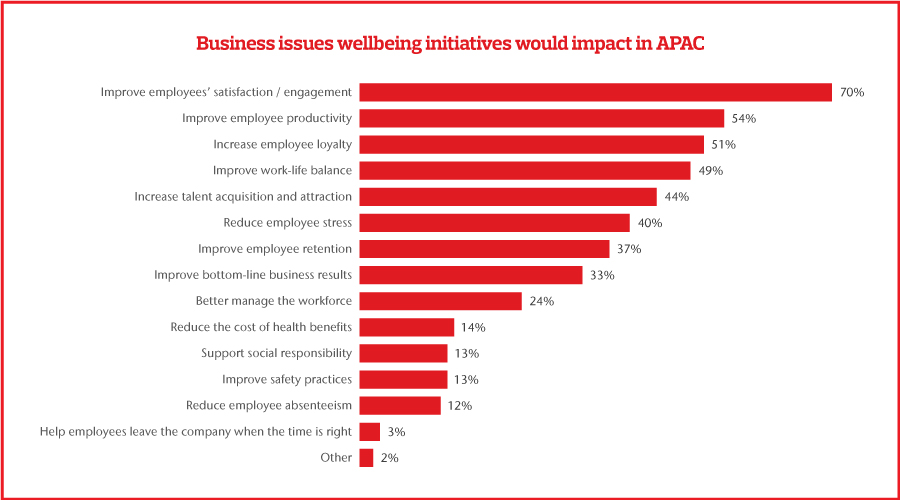
Aon’s 2021 Global Wellbeing Survey found that a 4 percent increase in wellbeing performance yields a 1 percent profit increase, as well as a 1 percent reduction in employee turnover. In addition to operating at higher levels of satisfaction and engagement, 51 percent of the respondents reported being more willing to promote or speak highly of their organization. “This is why the time has come for wellbeing to be emphasized as a business risk, instead of just another item on the budget,” Dr Deka explains.
Wellbeing as a strategy, not initiative
To shape an organization’s work environment and culture from within, one-off or short-term initiatives and programmes are not enough, says Amanda Mercep, head of Wellbeing Solutions, North Asia, Aon. “Rather than confine it to a HR-only discussion, wellbeing must permeate the business under a holistic and strategic approach for it to be truly meaningful.”
Unfortunately, Aon’s 2021 Global Wellbeing Survey has found that APAC is struggling the most with integration, displaying the largest gap between organizations that have a wellbeing initiative in place (90 percent) and those that have a strategy instead (55 percent). Among other factors, 41 percent of the respondents felt that employee engagement has been a challenge.
The costs vs. benefits of wellbeing
The biggest barrier to implementing a wellbeing strategy appears to be financially motivated. More than half (55 percent) of the respondents in Aon’s 2021 Global Wellbeing Survey cited a lack of resources to be an issue, while 49 percent of the respondents admitted to having trouble understanding how to measure wellbeing-related ROIs.
Why companies aren’t prioritizing wellbeing
While the nature of leadership support in APAC is on par with global levels, and considering business implications and that APAC as a region is struggling the most to integrate wellbeing into its organizational strategy, wellbeing needs to expand beyond an HR-only discussion, into the realm of business strategy.
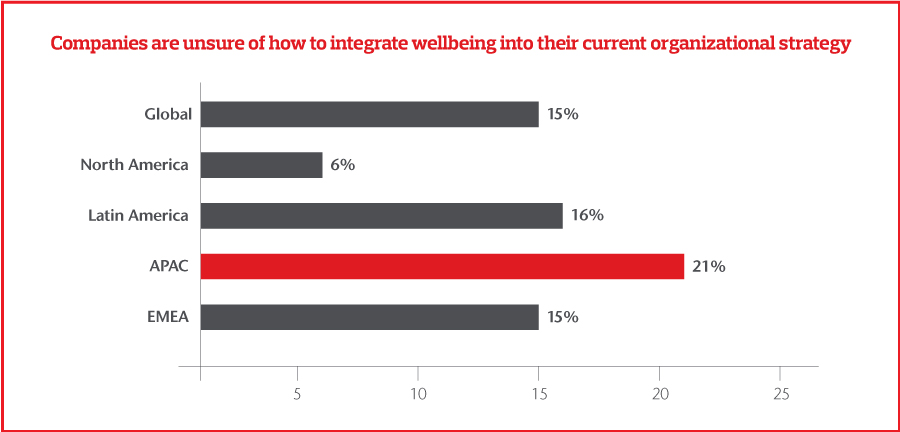
“Although the COVID-19 pandemic was a catalyst for many organizations to revamp their wellbeing policies, plans did not materialize for 23 percent of the respondents that were hindered by safety concerns and 29 percent of them that mentioned remote working arrangements as a drawback,” says Mercep.
The importance of well-informed decisions
Ultimately, wellbeing will be driven by data analysis and innovation. “Simply put, organizations will be able to maximize value for cost on their strategy by targeting resources based on insights,” says Dr. Deka.
A glimpse into the future of wellbeing around the world
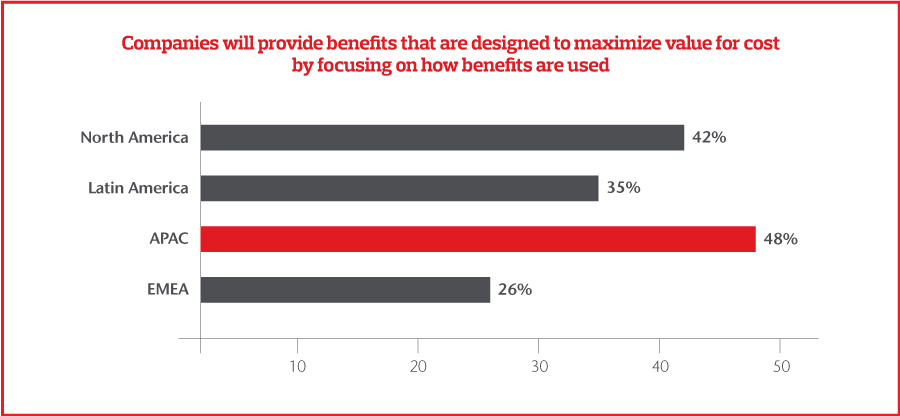
“To harness the power of wellbeing, businesses will need to recognize the complexities involved and the interconnections between each dimension to reduce risks, improve performance and build resilience in the long run,” he elaborates.
